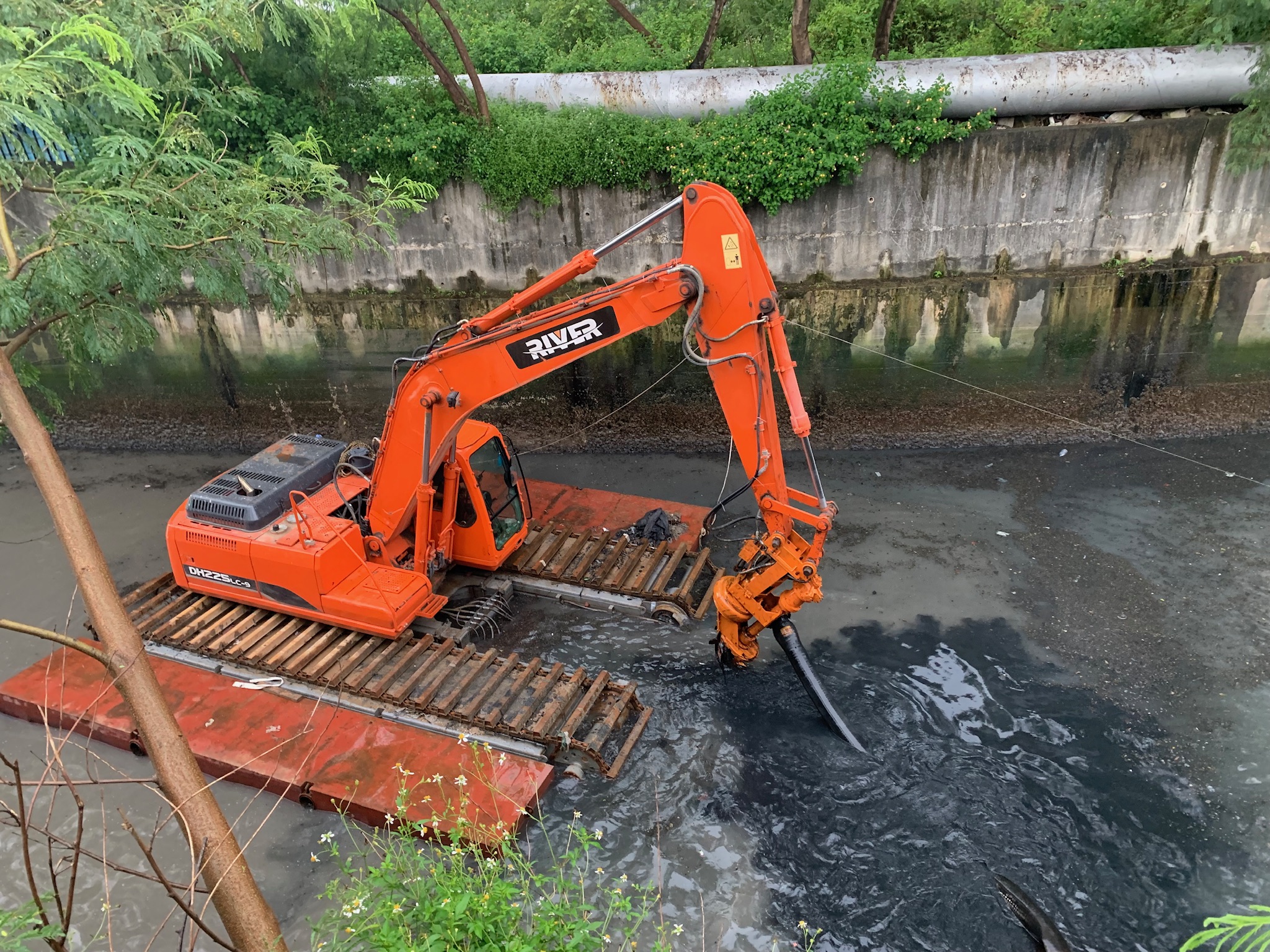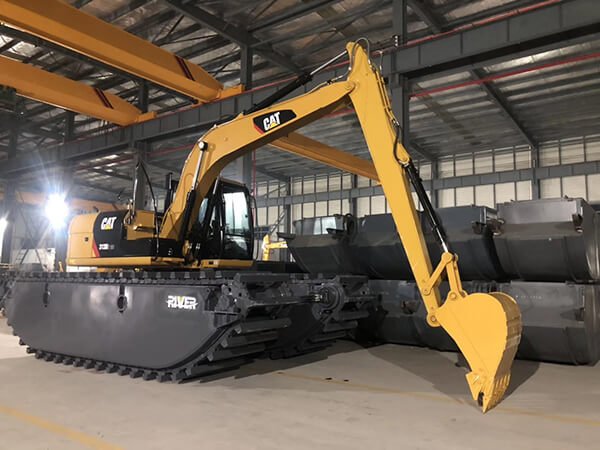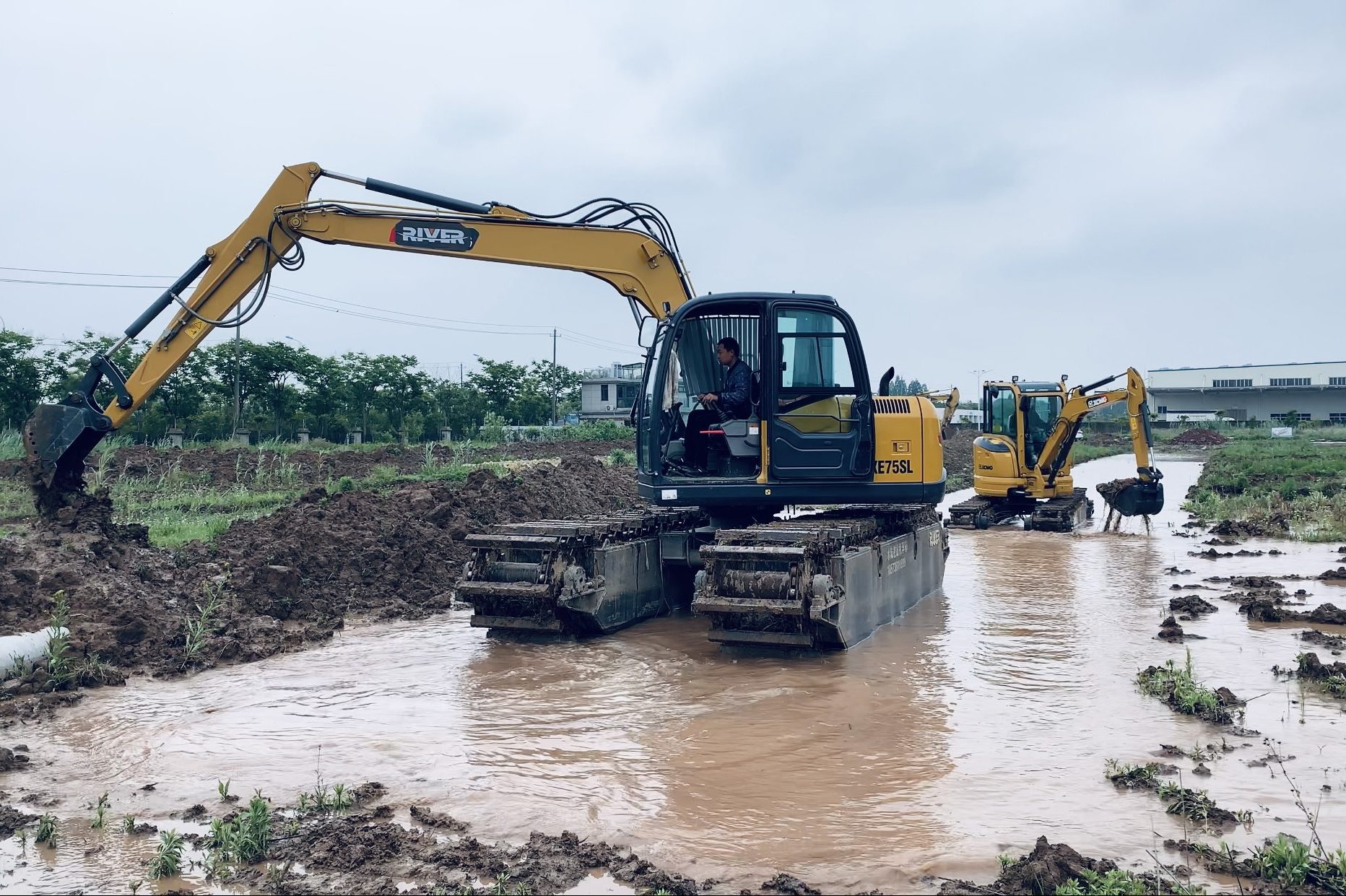Excavating in marshy or waterlogged terrains presents unique challenges that require specialized equipment. While traditional excavators are commonly used in a variety of construction and digging projects, their performance can be severely limited in wetland environments. This is where swamp excavators come into play, specifically designed to navigate through muddy and unstable ground.
In this article, we’ll explore the differences between swamp excavators and traditional excavators, helping you determine which option is better suited for working in marshy terrains.
What Is a Swamp Excavator?
A swamp excavator, also known as an amphibious excavator, is a specialized piece of equipment designed for work in wet, marshy, or swampy areas. Unlike traditional excavators, which struggle in soft, waterlogged terrain, swamp excavators feature oversized, wide tracks that distribute their weight more evenly, preventing them from sinking. These tracks, often referred to as pontoons, allow the machine to float or move through deep mud, shallow water, and other challenging environments.
Swamp excavators are commonly used for tasks like dredging, wetland restoration, and working in flood-prone areas where traditional equipment would get stuck or become inefficient. Their unique design makes them the go-to choice for projects that require mobility and stability in difficult terrain.
Learn more about swamp excavator please visit: https://www.riverexcavator.net/what-is-amphibious-excavator-what-is-its-application/
Traditional Excavator: How do They Perform in Wetlands?
Traditional excavators are versatile and effective for most construction projects, but their performance drops significantly in wetlands. Their standard tracks are not designed to handle soft, marshy terrain, leading to issues like sinking or getting stuck. In waterlogged areas, traditional excavators struggle with traction and stability, making them less efficient and even risky to use in such conditions.
- Poor traction: Traditional tracks sink in soft, wet ground.
- Increased risk of getting stuck: Marshy areas can trap these machines easily.
- Reduced efficiency: Slower movement and reduced digging capacity in wet conditions.
- Potential equipment damage: Mud and water can cause wear on parts not built for such environments.
- Limited mobility: Traditional excavators cannot easily move through water or deep mud.

amphibious excavator
Key Differences Between Swamp And Traditional Excavators
Swamp and traditional excavators may perform similar tasks, but they are designed for very different environments. Their key differences lie in their structure, mobility, and ability to handle difficult terrain. Here’s how these two types of machines compare:
Chassis and Track Design
The chassis of an amphibious excavator is combined with wide track pontoons to evenly distribute its weight across soft and unstable terrain. These pontoons are sealed to provide buoyancy, allowing the excavator to operate in shallow water environments, though they are not designed for navigation. This design helps the machine stay afloat and work efficiently in marshy conditions where traditional excavators would struggle.
Full Rotation and Hydraulic Operation
Amphibious excavators are equipped with a crawler pontoon, a long arm, and a spud, which together enable 360° rotation and versatile hydraulic operation. The spud can be extended into the soil and water bodies, anchoring the machine in place for stable excavation or dredging. This capability allows for precise and effective work in challenging environments, providing enhanced operational flexibility compared to traditional equipment.
Dredging and Excavation Capabilities
Amphibious excavators are more suited for specific tasks like removing silty clay, clearing silt ditches, and performing swampy or shallow water operations. They excel in these applications due to their specialized design, which offers better performance in such conditions compared to traditional barge-type dredgers, making them a more effective choice for these types of projects.
Simplified Operation and Cost Efficiency
Using an amphibious excavator simplifies the excavation process by allowing direct access to the work site via its crawler pontoons. This reduces the need for additional equipment or extensive site preparation, leading to cost savings and optimized operational time. The straightforward operation of amphibious excavators makes them a practical and economical choice for projects in marshy or shallow water environments.
Mobility in Water
A swamp excavator can operate in shallow water or flooded areas without getting stuck, as its design allows it to float. Traditional excavators are not built for aquatic environments and may become immobilized when submerged in water or deep mud.
Application and Use Cases
Swamp excavators are commonly used in projects like wetland restoration, dredging, and flood control. Traditional excavators are more suitable for general construction projects, land clearing, and road building on stable ground.
Land Preparation
Traditional excavators often require the land to be drained or reinforced before work can begin in wet or marshy areas. Without proper drainage, they risk getting stuck or damaged, delaying the project and increasing costs.
Handling Vegetation and Shallow Water
Swamp excavators are designed to move effortlessly through thick vegetation, shallow water, and muddy areas. Their wide tracks allow them to glide over challenging terrain that would be impassable for traditional excavators, making them ideal for projects in wetlands and flood prone regions.
Weight Distribution
Swamp excavators have a much broader footprint due to their wide pontoons, distributing their weight evenly over soft surfaces. This prevents them from sinking into the ground. In contrast, traditional excavators have narrower tracks, which concentrate their weight in smaller areas, causing them to sink or get stuck in marshy terrain.
Speed and Efficiency
Swamp excavators are slower on dry land but excel in wet conditions where traditional excavators would struggle or fail. Traditional excavators are more efficient on firm ground, offering better speed and digging power on stable surfaces, but their efficiency drops drastically in waterlogged areas.
Maintenance Needs
Swamp excavators typically require more specialized maintenance due to their amphibious nature and exposure to water and mud. Traditional excavators, while requiring regular upkeep, are easier to maintain in standard construction settings, with fewer risks of water-related damage.

When to Choose a Swamp Excavator Over a Traditional Excavator
Choosing between a swamp excavator and a traditional excavator depends on the terrain and specific project needs. Swamp excavators are the clear choice for areas with soft, wet, or unstable ground, where traditional excavators would struggle or fail. Here are some scenarios when a swamp excavator is the better option:
- Wetlands or marshy areas: If the worksite is in a swamp, wetland, or any terrain with waterlogged soil, a swamp excavator will provide the necessary stability and mobility.
- Projects in shallow water: Swamp excavators are designed to handle shallow water, making them ideal for dredging, flood management, or shoreline projects.
- Thick vegetation: In areas with dense vegetation or muddy conditions, swamp excavators can navigate through without sinking or getting stuck.
- No land preparation required: When draining or reinforcing the land isn’t feasible, swamp excavators allow for immediate operation without extra groundwork.
In short, when working in waterlogged, muddy, or vegetated environments, a swamp excavator will outperform a traditional excavator every time.
Wrap-Up!
When working in marshy or waterlogged terrains, choosing the right equipment is essential. While traditional excavators are versatile and efficient on firm ground, they struggle in wetlands where swamp excavators excel. With their specialized design, swamp excavators offer greater stability, mobility, and performance in challenging environments.
Whether navigating through thick vegetation, shallow waters, or unstable ground, swamp excavators are the clear choice for projects that require working in difficult terrains. Understanding the differences between these machines ensures you select the best option for your specific project needs.

